Study on Variations in Climatic Variables and Their Influence on Runoff in the Manas River Basin, China
Abstract
:1. Introduction
2. Study Area and Data Descriptions
3. Methodology
3.1. Trend Test
3.2. Abrupt Change Point Analysis
3.3. Partial Correlation Method
3.4. Bias Correction Method
3.5. Snowmelt Module
3.6. The TOPMODEL Description
3.7. Calibration and Validation of the Model
4. Results and Discussion
4.1. Variation of Annual Precipitation, Temperature and Runoff
4.2. Correlation Analysis between Climatic Variables and Runoff
4.3. Model Calibration and Validation
4.4. Climate Change in the Future
4.5. Influence of Climate Change on Runoff
5. Conclusions
- The annual runoff and climatic variables all show increasing trends during the period from 1961 to 2015. The abrupt change point of annual runoff (1995) is similar to the climatic variables (1992, 1994, 1993 and 1994 of annual precipitation, MAT, LAT, and HAT respectively). The runoff is supplied by precipitation rather than snowmelt in the winter season, and the opposite is true in the spring and autumn. During the summer season, the recharge of precipitation and snowmelt to runoff are almost identical.
- The bias-corrected monthly mean temperature data of the chosen GCMs, which are MPI-ESM-MR, FGOALS-g2, and HadGEM2-AO, from 2021 to 2160 all increase compared with the baseline period from 1961 to 2000. The monthly mean temperature increases the most in “rcp8.5”. “rcp4.5” showed the next largest increase, and “rcp2.6” increased the least in all chosen GCMs. The monthly precipitation presents the greatest increasing change in the winter season, and the descending change in December in the “rcp2.6” emission scenario of MPI-ESM-MR, the “rcp2.6” and “rcp8.5” emission scenarios of HadGEM2-AO, and in February in the “rcp2.6” emission scenario of FGOALS-g2.
- The monthly runoff from 2021 to 2060 simulated by the modified TOPMODEL with different emission scenarios in different GCMs all increase compared with the baseline period, and will increase by 24.39%, 25.82%, and 29.98% in “rcp2.6”, “rcp4.5”, and “rcp8.5” emission scenarios, respectively, of MPI-ESM-MR, 29.36%, 32.34%, and 30.96% of FGOALS-g2, and 26.13%, 30.62%, and 34.28% of HadGEM2-AO. The largest increasing change often occurs in April. The runoff increases significantly more from late winter to spring than in the other months.
Acknowledgments
Author Contributions
Conflicts of Interest
References
- Fu, G.B.; Charles, S.P.; Chiew, F.H.S. A two-parameter climate elasticity of streamflow index to assess climate change effects on annual streamflow. Water Resour. Res. 2007, 43, W11401. [Google Scholar] [CrossRef]
- Ralph, A.W.; Ranjan, S.M.; Felden, F. Incorporation of climate change in water availability modeling. J. Hydrol. Eng. 2005, 10, 375–385. [Google Scholar]
- Bronstert, A.; Kolokotronis, V.; Schwandt, D.; Straub, H. Comparison and evaluation of regional climate scenarios for hydrological impact analysis: General scheme and application example. Int. J. Climatol. 2007, 27, 1579–1594. [Google Scholar] [CrossRef]
- Chen, Y.; Takeuchi, K.; Xu, C.; Chen, Y.; Xu, Z. Regional climate change and its effects on river runoff in the Tarim Basin, China. Hydrol. Process. 2006, 20, 2207–2216. [Google Scholar] [CrossRef]
- Wu, C.H.; Huang, G.R.; Yu, H.J. Prediction of extreme floods based on CMIP5 climate models: A case study in the Beijiang River basin, South China. Hydrol. Earth Syst. Sci. 2015, 19, 1385–1399. [Google Scholar] [CrossRef]
- Ma, C.K.; Sun, L.; Liu, S.Y.; Shao, M.A.; Luo, Y. Impact of climate change on the streamflow in the glacierized Chu River Basin, Central Asia. J. Arid Land 2015, 7, 501–513. [Google Scholar] [CrossRef]
- Alfieri, L.; Burek, P.; Feyen, L.; Forzieri, G. Global warming increases the frequency of river floods in Europe. Hydrol. Earth Syst. Sci. 2015, 19, 2247–2260. [Google Scholar] [CrossRef]
- Jones, R.N.; Chiew, F.H.S.; Boughton, W.C.; Zhang, L. Estimating the sensitivity of mean annual runoff to climate change using selected hydrological models. Adv. Water Resour. 2006, 29, 1419–1429. [Google Scholar] [CrossRef]
- Legesse, D.; Abiye, T.A.; Vallet-Coulomb, C.; Abate, H. Streamflow sensitivity to climate and land cover changes: Meki River, Ethiopia. Hydrol. Earth Syst. Sci. 2010, 14, 2277–2287. [Google Scholar] [CrossRef]
- Dan, L.; Ji, J.J.; Xie, Z.H.; Chen, F.; Wen, G.; Richey, J.E. Hydrological projections of climate change scenarios over the 3H region of China: A VIC model assessment. J. Geophys. Res. Atmos. 2012, 117. [Google Scholar] [CrossRef]
- Kabiri, R.; Bai, V.R.; Chan, A. Assessment of hydrologic impacts of climate change on the runoff trend in Klang Watershed, Malaysia. Environ. Earth Sci. 2015, 73, 27–37. [Google Scholar] [CrossRef]
- Lopez, S.R.; Hogue, T.S.; Stein, E.D. A framework for evaluating regional hydrologic sensitivity to climate change using archetypal watershed modeling. Hydrol. Earth Syst. Sci. 2013, 17, 3077–3094. [Google Scholar] [CrossRef]
- Wang, W.G.; Wei, J.D.; Shao, Q.X.; Xing, W.Q.; Yong, B.; Yu, Z.B.; Jiao, X.Y. Spatial and temporal variations in hydro-climatic variables and runoff in response to climate change in the Luanhe River basin, China. Stoch. Environ. Res. Risk Assess. 2015, 29, 1117–1133. [Google Scholar] [CrossRef]
- Sun, W.C.; Wang, J.; Li, Z.J.; Yao, X.L.; Yu, J.S. Influences of climate change on water resources availability in Jinjiang Basin, China. Sci. World J. 2014, 2014, 908349. [Google Scholar] [CrossRef] [PubMed]
- Zhao, J.; Shi, Y.F.; Huang, Y.S.; Fu, J.W. Uncertainties of snow cover extraction caused by the nature of topography and underlying surface. J. Arid Land 2015, 7, 285–295. [Google Scholar] [CrossRef]
- Luo, Y.; Arnold, J.; Liu, S.Y.; Wang, X.Y.; Chen, X. Inclusion of glacier processes for distributed hydrological modeling at basin scale with application to a watershed in Tianshan Mountains, northwest China. J. Hydrol. 2013, 477, 72–85. [Google Scholar] [CrossRef]
- Ling, H.B.; Xu, H.L.; Fu, J.Y.; Liu, X.H. Surface runoff processes and sustainable utilization of water resources in Manas River Basin, Xinjiang, China. J. Arid Land 2012, 4, 271–280. [Google Scholar] [CrossRef]
- Shi, Y.; Shen, Y.; Kang, E.; Li, D.; Ding, Y.; Zhang, G.; Hu, R. Recent and future climate change in northwest china. Clim. Chang. 2007, 80, 379–393. [Google Scholar] [CrossRef]
- He, X.L.; Guo, S.L. Impacts of climate change on hydrology and water resources in the Manas River Basin. Adv. Water Sci. 1998, 9, 77–83. [Google Scholar]
- Wu, J.; Gao, X.J. A Gridded daily observation dataset over china region and comparison with the other datasets. Chin. J. Geophys. 2013, 56, 1102–1111. (In Chinese) [Google Scholar]
- Taylor, K.E.; Stouffer, R.J.; Meehl, G.A. An Overview of CMIP5 and the Experiment Design. Bull. Am. Meteorol. Soc. 2012, 93, 485–498. [Google Scholar] [CrossRef]
- Li, L.; Simonovic, S.P. System dynamics model for predicting floods from snowmelt in North American prairie watersheds. Hydrol. Process. 2002, 16, 2645–2666. [Google Scholar] [CrossRef]
- Zhang, Y.C.; Li, B.L.; Bao, A.M.; Zhou, C.H.; Chen, X.; Zhang, X.R. Study on snowmelt runoff simulation in the Kaidu River basin. Sci. China Ser. D 2007, 50, 26–35. [Google Scholar] [CrossRef]
- Li, X.M.; Zhang, F.Y.; Shang, M.; Abduweli, J.; Li, L.H. Path analysis on impacts of meterological factors on runoff from tianshan mountains: A case study on Manas River and Kaidu River watersheds. Resour. Sci. 2012, 34, 652–659. (In Chinese) [Google Scholar]
- Xu, C.H.; Wang, F.T.; Li, Z.Q.; Wang, L.; Wang, P.Y. Glacier variation in the Manas River Basin during the period from 1972 to 2013. Arid Zone Res. 2016, 33, 628–635. (In Chinese) [Google Scholar]
- ESGF Node at DKRZ. Available online: https://esgf-data.dkrz.de/projects/esgf-dkrz/ (accessed on 31 March 2017).
- Zhang, Y.W.; Zhang, L.; Xu, Y. Simulations and projections of the surface air temperature in China by CMIP5 models. Clim. Chang. Res. 2016, 12, 10–19. (In Chinese) [Google Scholar]
- Chen, X.C.; Xu, Y.; Xu, C.H.; Yao, Y. Assessment of Precipitation Simulations in China by CMIP5 Multi-models. Prog. Inquis. Mutat. Clim. 2014, 10, 217–225. (In Chinese) [Google Scholar]
- Zhang, B.; Gong, Y.F.; Xu, Y.; Zhang, S. Evaluation on the simulation of the drought change in China based on global climate models from CMIP5. J. Arid Meteorol. 2014, 32, 694–700. (In Chinese) [Google Scholar]
- Serrano, V.L.; Mateos, V.L.; Garcia, J.A. Trend analysis of monthly precipitation over the Iberian Peninsula for the period 1865–2002. Hydrol. Process. 1999, 23, 1147–1157. [Google Scholar]
- Kendall, M.G. Rank Correlation Methods; Charles Griffin: London, UK, 1975. [Google Scholar]
- Mann, H.B. Nonparametric tests against trend. Econometrica 1945, 13, 245–259. [Google Scholar] [CrossRef]
- Serrano, A.; Mateos, V.L.; Garcia, J.A. Trend analysis of monthly precipitation over the Iberian Peninsula for the period 1921–1995. Phys. Chem. Earth Part B 1999, 24, 85–90. [Google Scholar] [CrossRef]
- Iman, R.L.; Helton, J.C. An investingation of uncertainty and sensitivity analysis techniques for computer models. Risk Anal. 1988, 8, 71–90. [Google Scholar] [CrossRef]
- Su, B.D.; Huang, J.L.; Gemmer, M.; Jian, D.N.; Tao, H.; Jiang, T.; Zhao, C.Y. Statistical downscaling of CMIP5 multi-model ensemble for projected changes of climate in the Indus River Basin. Atmos. Res. 2016, 178, 138–149. [Google Scholar] [CrossRef]
- Li, H.B.; Sheffield, J.; Wood, E.F. Bias correction of monthly precipitation and temperature fields from Intergovernmental Panel on Climate Change AR4 models using equidistant quantile matching. J. Geophys. Res. Atmos. 2010, 115. [Google Scholar] [CrossRef]
- Braithwaite, R.J. Calculation of degree-days for glacier-climatic research. Z. Gletsch. Glaziageol. 1984, 20, 1–8. [Google Scholar]
- Braithwaite, R.J.; Olesen, O.B. Calculation of glacier ablation from air temperature. In Glacier Fluctuation and Climate Change; Kluwer Academic Publishers: Dordrecht, The Netherlands, 1989; pp. 219–233. [Google Scholar]
- Cui, Y.H.; Ye, B.S.; Wang, J.; Liu, Y.C.; Jing, Z.F. Analysis of the spatial-temporal variations of the positive degree-day factors on the Glacier No. 1 at the headwaters of the Ürümqi River. J. Glaciol. Geocryol. 2010, 32, 265–274. (In Chinese) [Google Scholar]
- Quinn, P.; Beven, K.J.; Lamb, R. The ln(α/tanβ) index: How to calculate it and how to use it in the TOPMODEL framework. Hydrol. Process. 1995, 9, 161–182. [Google Scholar] [CrossRef]
- Beven, K.J.; Lamb, R.; Quinn, P.F.; Romanowicz, R.; Freer, J. TOPMODEL. In Computer Models of Watershed Hydrology; Singh, V.P., Ed.; Water Resources Publications: Douglas County, CO, USA, 1995; pp. 627–668. [Google Scholar]
- Beven, K.J.; Kirkby, M.J. A physically based variable contributing area model of basin hydrology. Hydrol. Sci. Bull. 1979, 24, 43–69. [Google Scholar] [CrossRef]
- Manandhar, S.; Pandey, V.P.; Ishidaira, H.; Kazama, F. Perturbation study of climate change impacts in a snow-fed river basin. Hydrol. Process. 2013, 27, 3461–3474. [Google Scholar] [CrossRef]
- Neary, V.S.; Habib, E.; Fleming, M. Hydrologic modeling with NEXRAD precipitation in middle Tennessee. J. Hydrol. Eng. 2004, 9, 339–349. [Google Scholar] [CrossRef]
- Nash, J.E.; Sutcliffe, J.V. River flow forecasting through conceptual models. Part I: A discussion of principles. J. Hydrol. 1970, 10, 282–290. [Google Scholar] [CrossRef]
- Geospacial Data Cloud. Available online: http://www.gscloud.cn/ (accessed on 31 March 2017).
- Zeng, X.; Lyu, J.H.; Shi, W.J. Analysis on runoff and flood characteristics of Manas River. J. Shihezi Univ. (Nat. Sci.) 2006, 24, 346–349. (In Chinese) [Google Scholar]
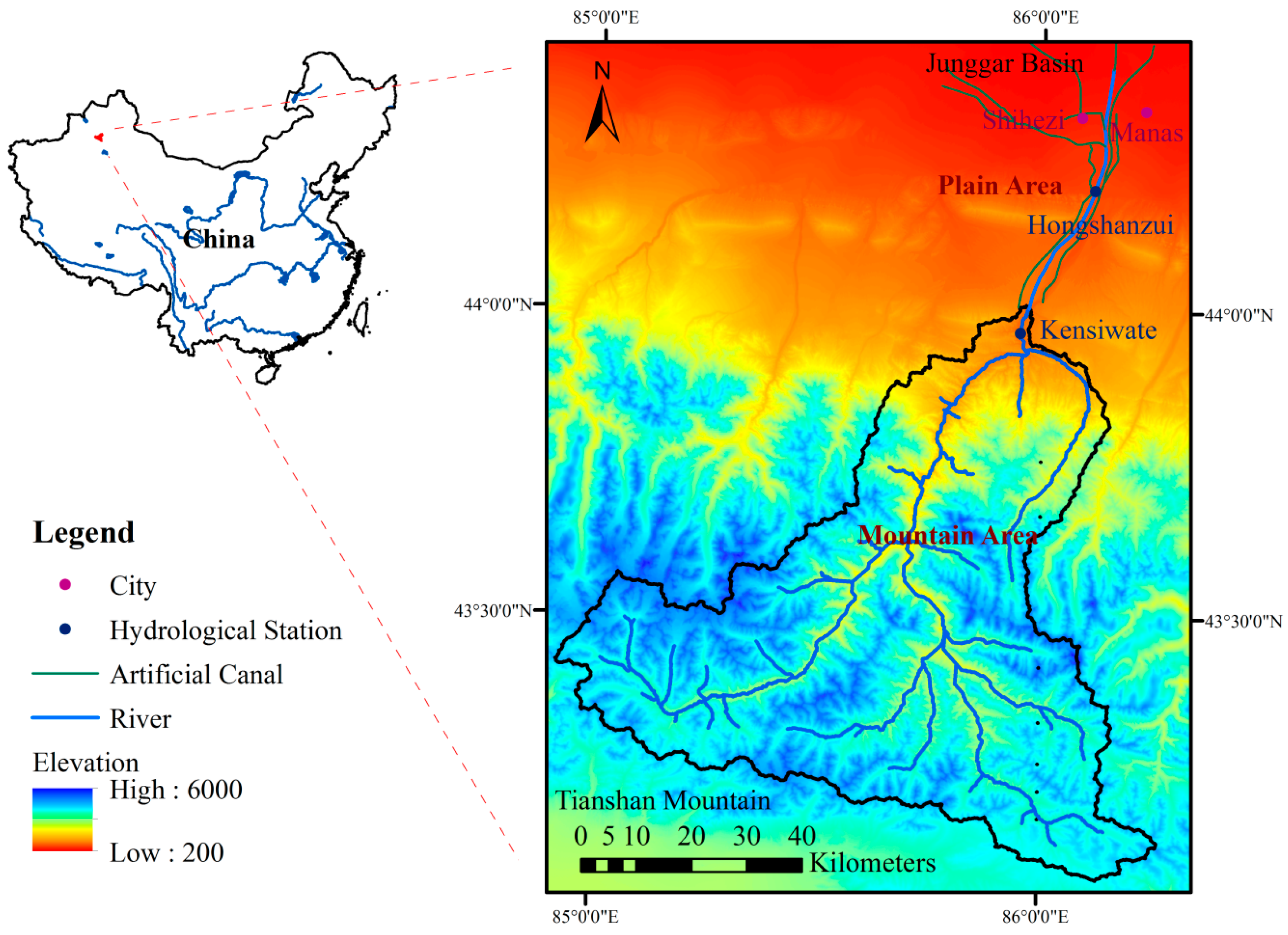
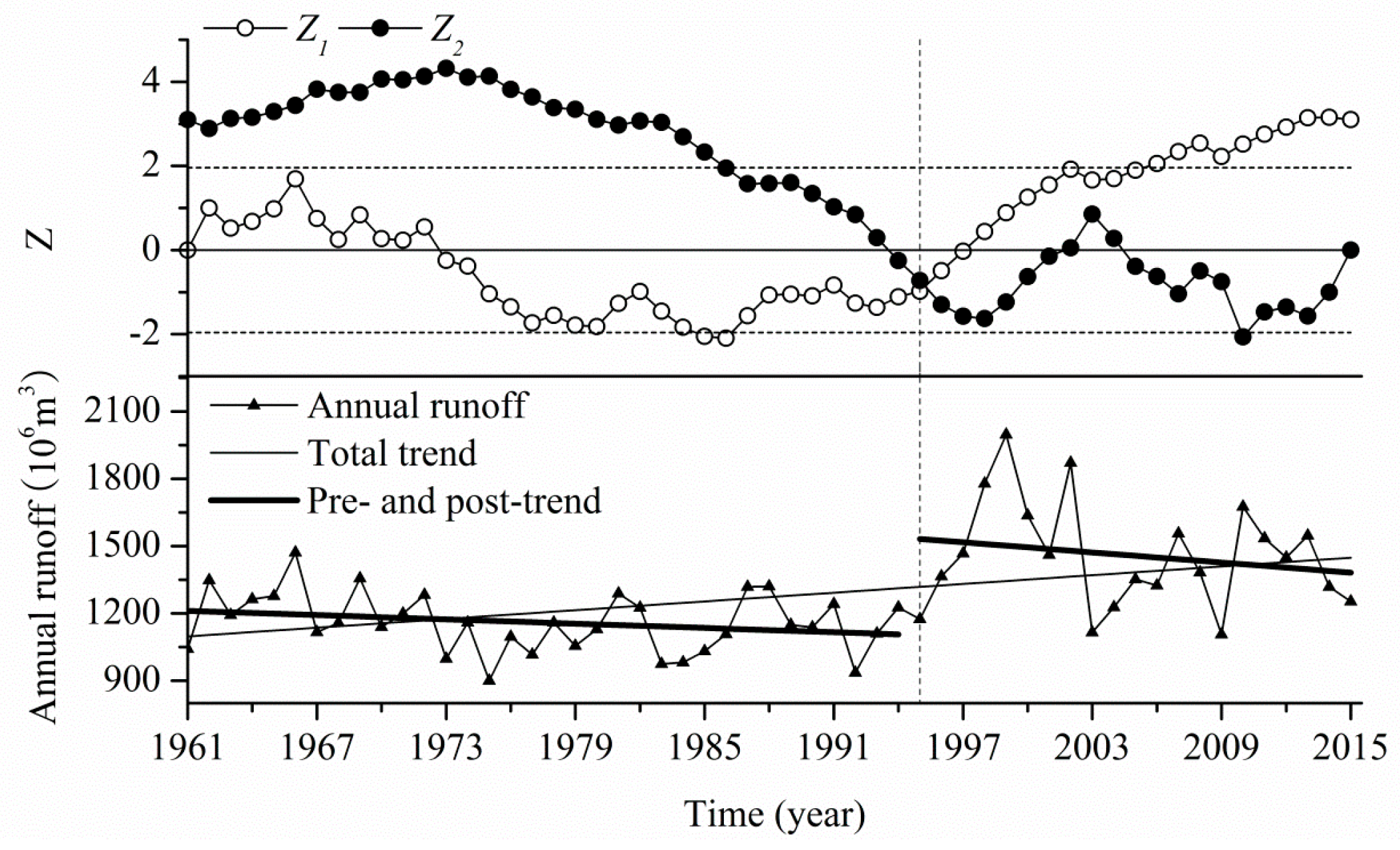
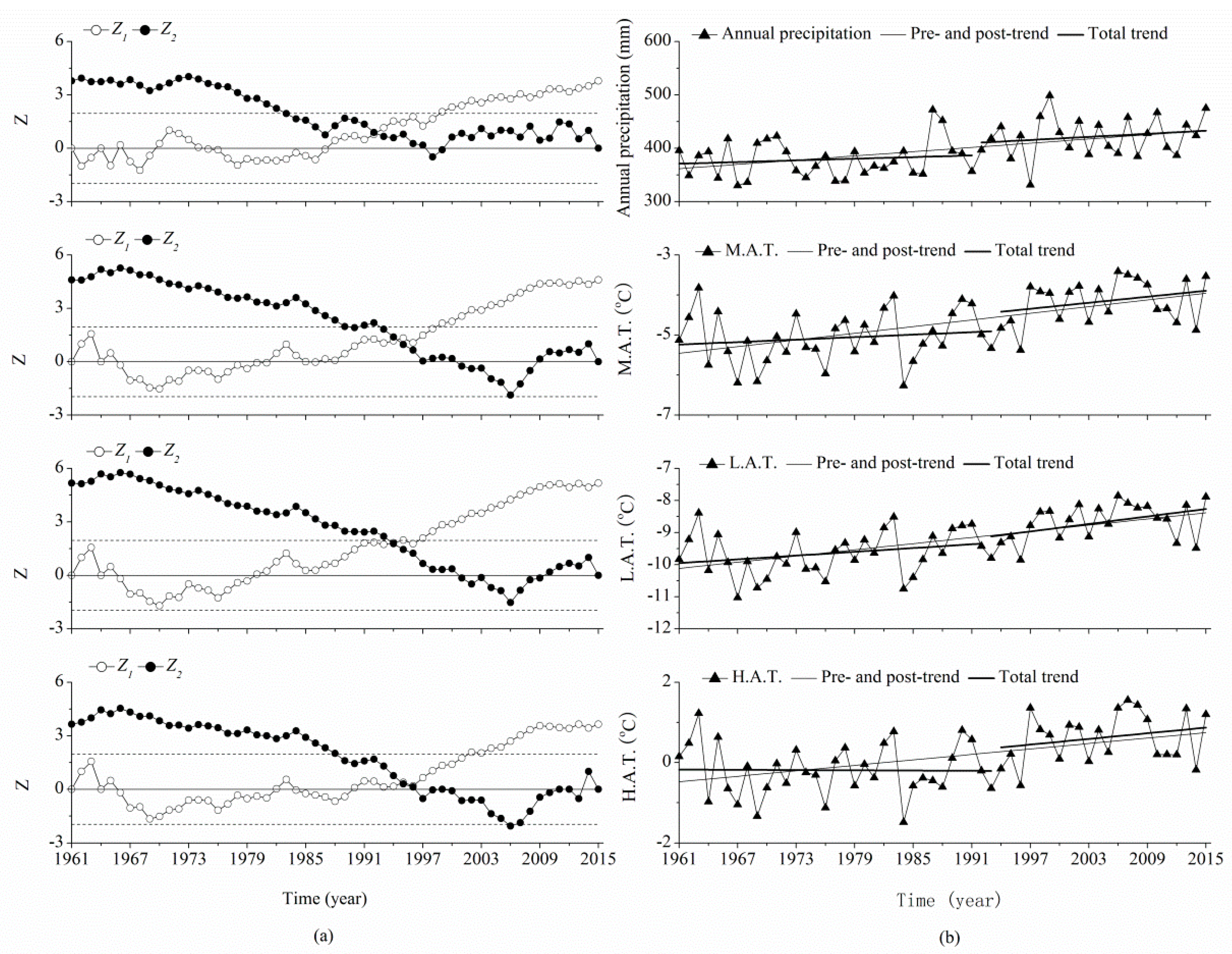
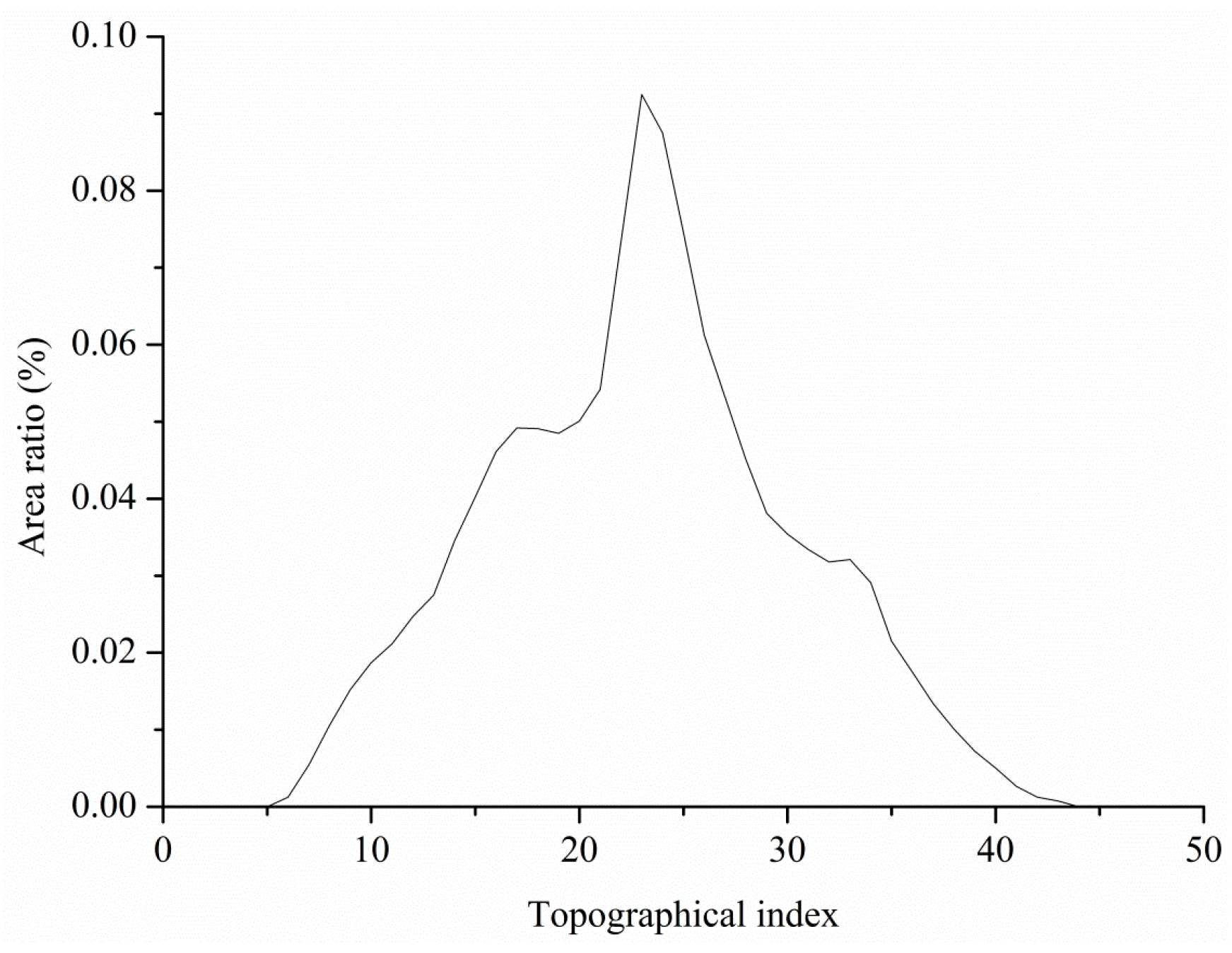
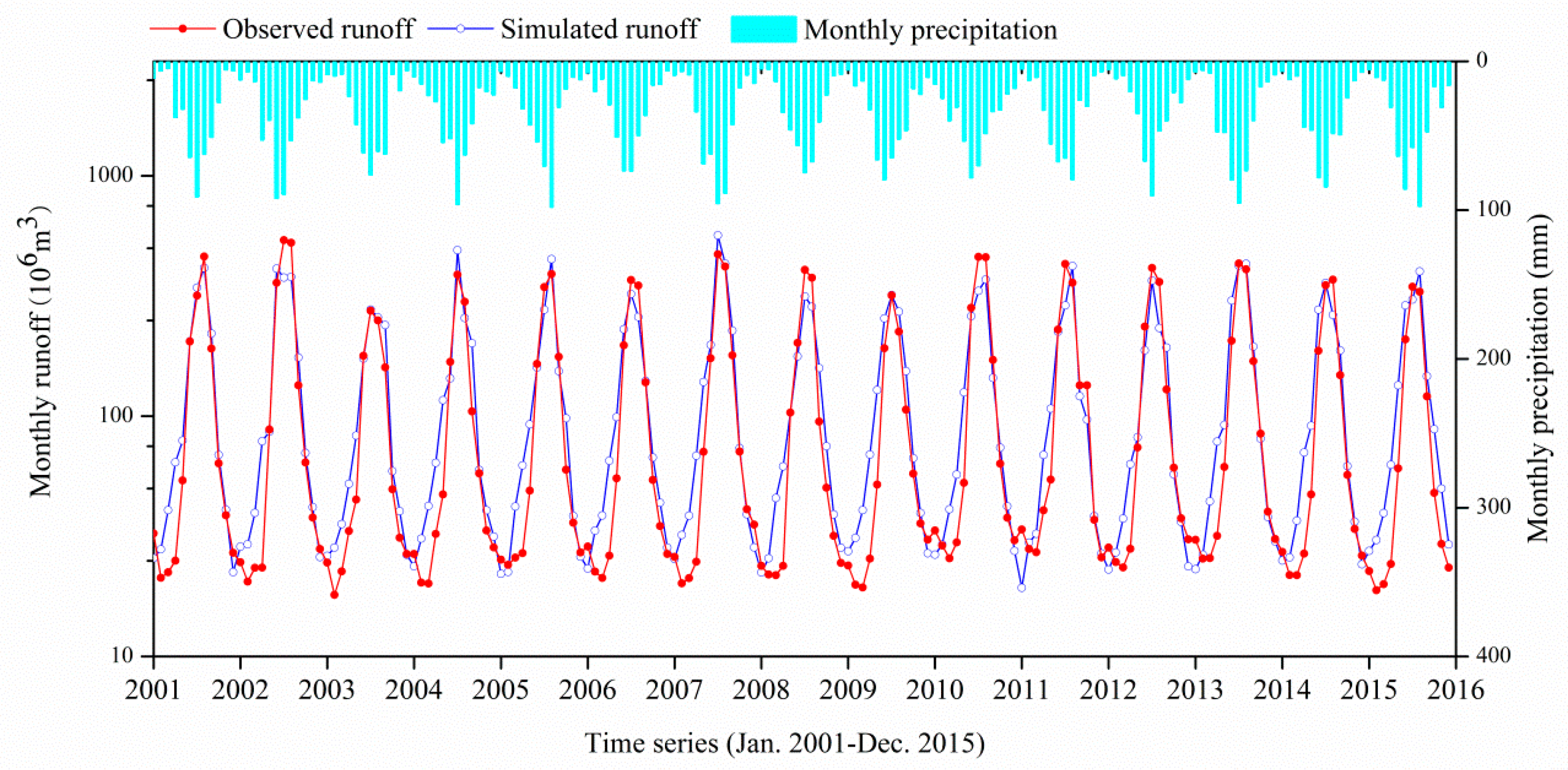
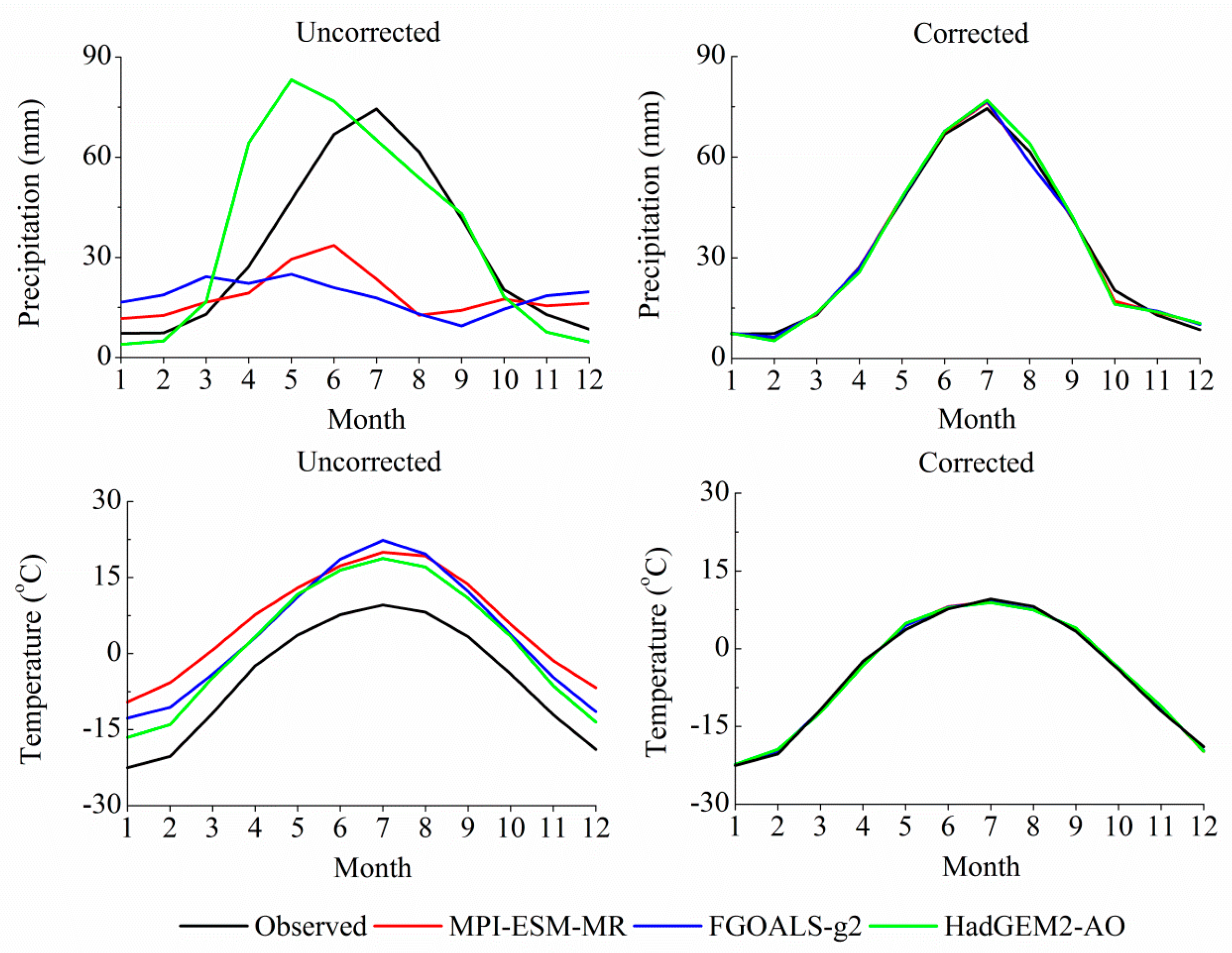
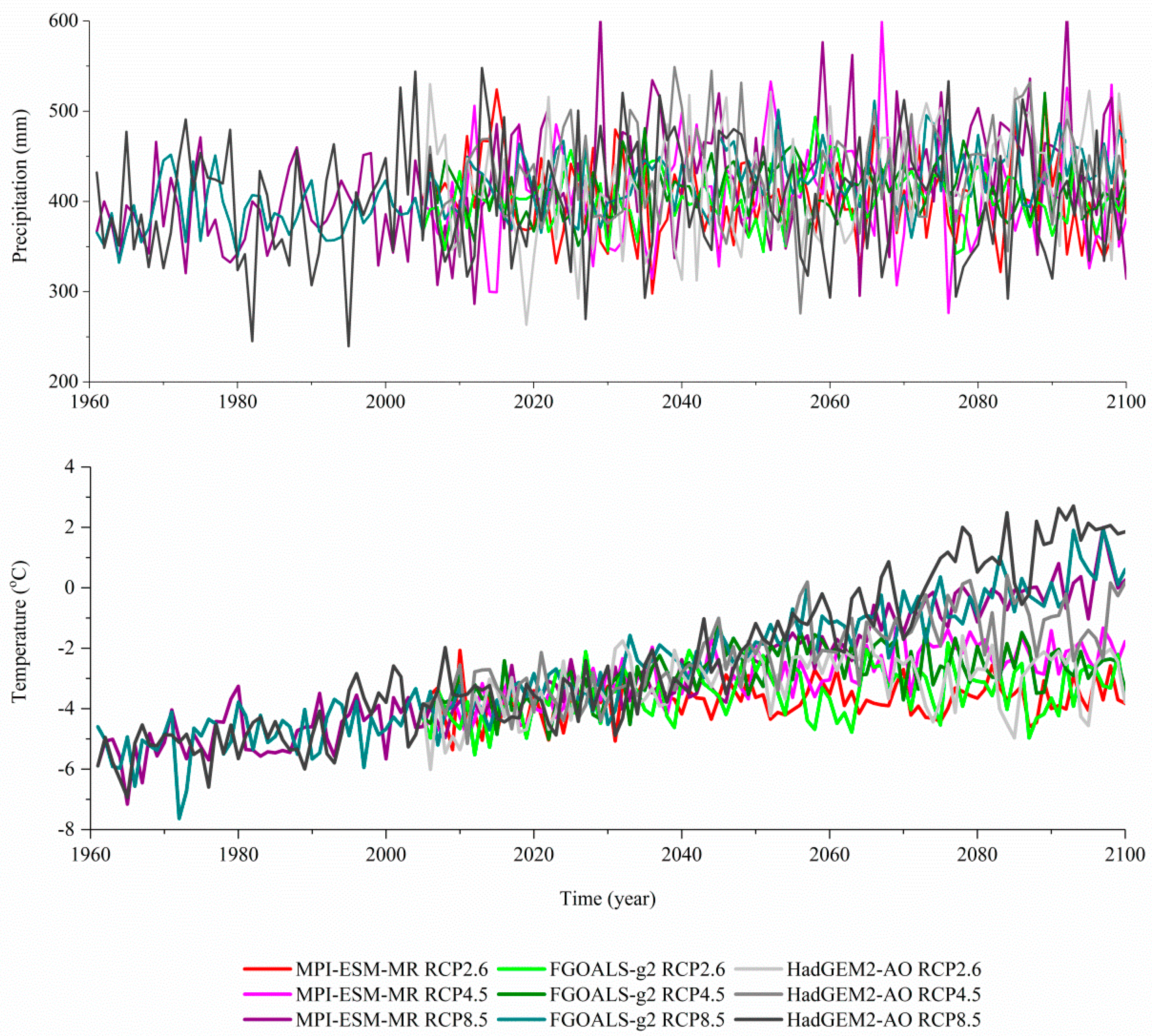
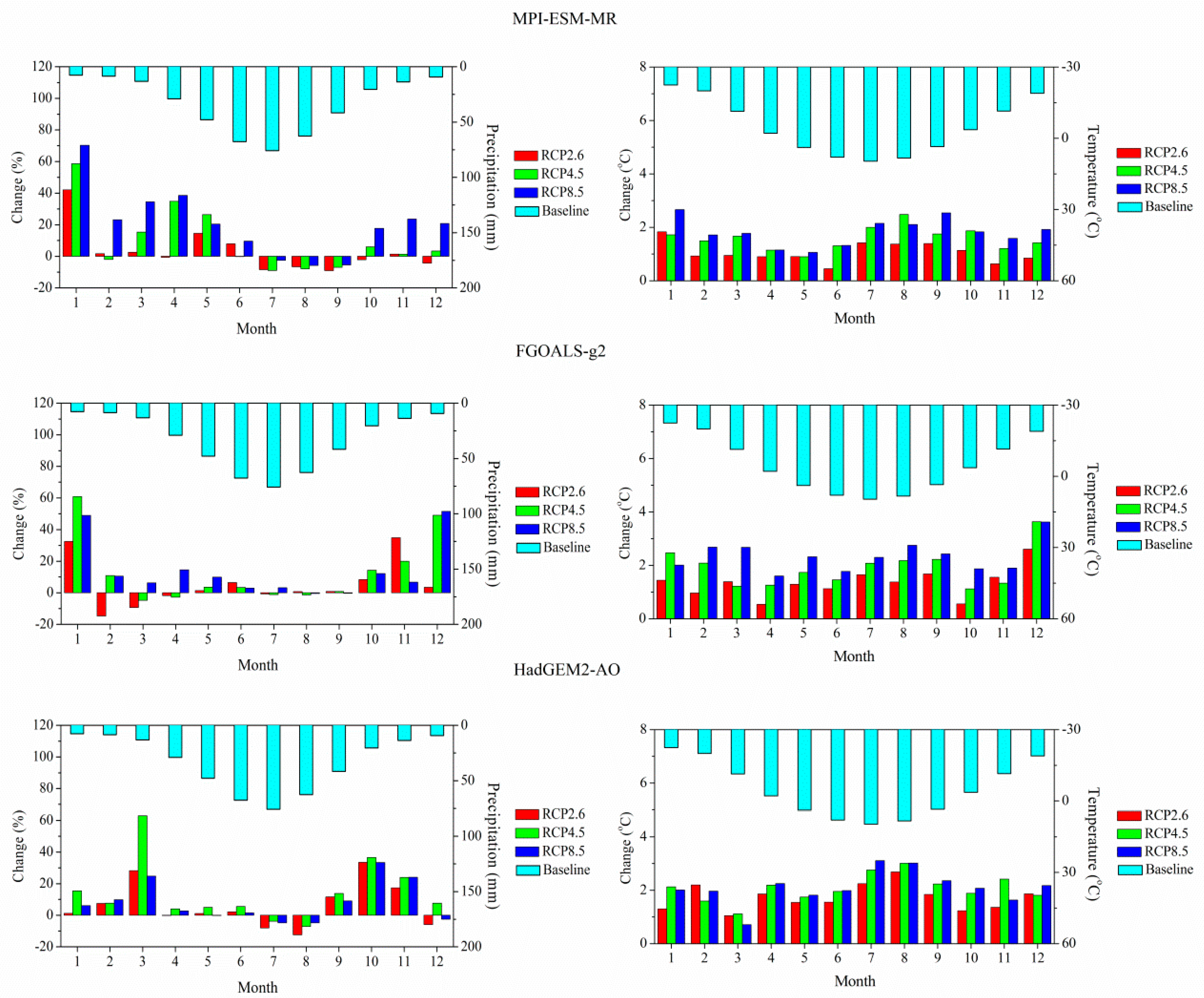
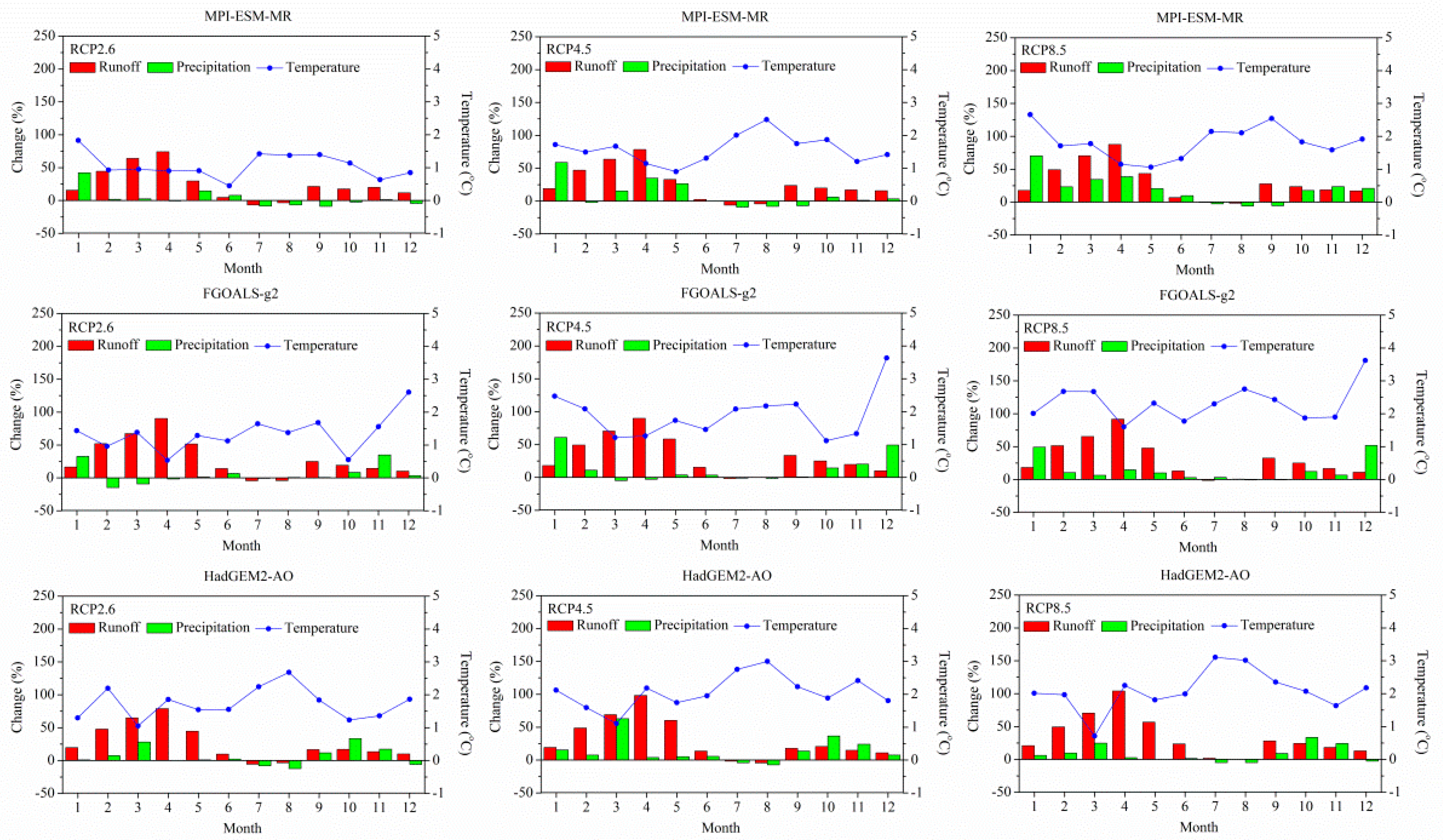
| Analysis Item | Data Period | Z | Critical Value | Significant Trend |
|---|---|---|---|---|
| Annual runoff | 1961–2015 | 3.09 | (−1.96, 1.96) | Increasing |
| Annual precipitation | 1961–2015 | 3.78 | (−1.96, 1.96) | Increasing |
| MAT | 1961–2015 | 4.59 | (−1.96, 1.96) | Increasing |
| LAT | 1961–2015 | 5.17 | (−1.96, 1.96) | Increasing |
| HAT | 1961–2015 | 3.64 | (−1.96, 1.96) | Increasing |
| Analysis Item | Change Point | Pre-Trend Rate * | Post-Trend Rate ** | Total Trend Rate *** | Change **** |
|---|---|---|---|---|---|
| Annual runoff | 1995 | −3.1852 | −7.5200 | 6.4981 | −4.3348 |
| Annual precipitation | 1992 | 0.5155 | 0.9611 | 1.3244 | 0.4456 |
| MAT | 1994 | 0.0103 | 0.0250 | 0.0278 | 0.0147 |
| LAT | 1993 | 0.0196 | 0.0389 | 0.0321 | 0.0193 |
| HAT | 1994 | −0.0010 | 0.0236 | 0.0227 | 0.0246 |
| Time | Precipitation | Mean Temperature | Lowest Temperature | Highest Temperature |
|---|---|---|---|---|
| January | 0.3736 * | 0.0054 | 0.0325 | −0.0568 |
| February | 0.3156 * | 0.1718 | 0.2157 | 0.1032 |
| March | 0.0451 | 0.2050 | 0.1456 | 0.2540 |
| April | 0.1179 | 0.3773 * | 0.3960 * | 0.3793 * |
| May | −0.0175 | 0.4937 * | 0.5156 * | 0.4665 * |
| June | 0.3158 * | 0.3474 * | 0.4705 * | 0.2699 * |
| July | 0.4263 * | 0.3619 * | 0.6187 * | 0.2308 |
| August | 0.4679 * | 0.4378 * | 0.5682 * | 0.3204 * |
| September | 0.2067 | 0.5131 * | 0.5717 * | 0.4330 * |
| October | 0.2138 | 0.3240 * | 0.3437 * | 0.2963 * |
| November | 0.0213 | 0.2757 * | 0.2652 | 0.2340 |
| December | 0.4008 * | 0.2447 | 0.2358 | 0.1955 * |
| Spring | 0.0817 | 0.3147 * | 0.3064 * | 0.3169 * |
| Summer | 0.6116 * | 0.4690 * | 0.6085 * | 0.3564 * |
| Autumn | 0.1186 | 0.5379 * | 0.5387 * | 0.4850 * |
| Winter | 0.5797 * | 0.1644 | 0.2149 | 0.0595 |
| Annual | 0.5704 | 0.4368 * | 0.4716 * | 0.3681 * |
© 2017 by the authors. Licensee MDPI, Basel, Switzerland. This article is an open access article distributed under the terms and conditions of the Creative Commons Attribution (CC BY) license (http://creativecommons.org/licenses/by/4.0/).
Share and Cite
Ren, L.; Xue, L.-q.; Liu, Y.-h.; Shi, J.; Han, Q.; Yi, P.-f. Study on Variations in Climatic Variables and Their Influence on Runoff in the Manas River Basin, China. Water 2017, 9, 258. https://doi.org/10.3390/w9040258
Ren L, Xue L-q, Liu Y-h, Shi J, Han Q, Yi P-f. Study on Variations in Climatic Variables and Their Influence on Runoff in the Manas River Basin, China. Water. 2017; 9(4):258. https://doi.org/10.3390/w9040258
Chicago/Turabian StyleRen, Lei, Lian-qing Xue, Yuan-hong Liu, Jia Shi, Qiang Han, and Peng-fei Yi. 2017. "Study on Variations in Climatic Variables and Their Influence on Runoff in the Manas River Basin, China" Water 9, no. 4: 258. https://doi.org/10.3390/w9040258




